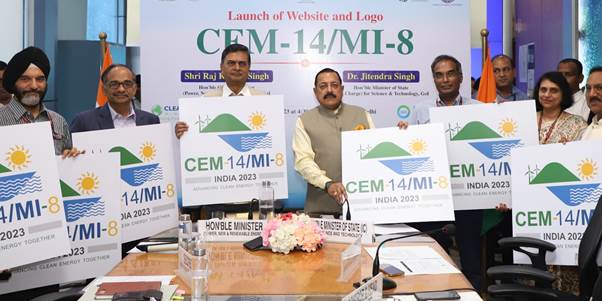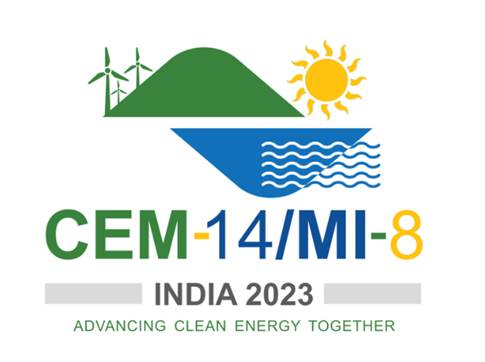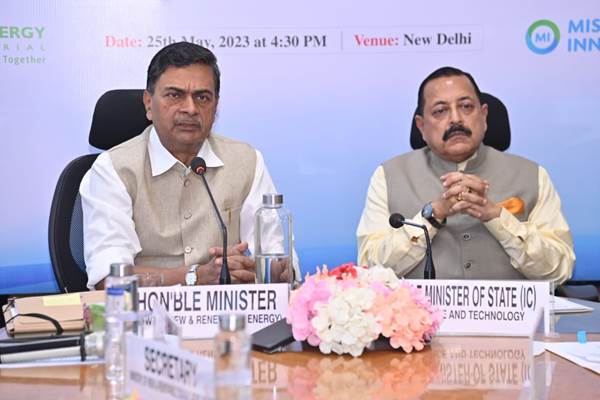The 14th Clean Energy Ministerial and 8th Mission Innovation Meeting (CEM14/MI-8) will be held in Goa from July 19 to 22 , 2023. The theme of CEM-14/MI-8 on the sidelines of the G-20 Energy Transition Ministerial Meeting is ‘ Advancing Clean Energy Together ‘ . This year’s Clean Energy Ministerial (CEM) and Mission Innovation (MI) meetings will bring together governments , international organizations , the private sector , academia , innovators , civil society , early career researchers and policy makers over a four-day event. These include high-level ministerial dialogue , global initiative launch ,Includes a wide range of award announcements , ministerial-CEO roundtables and many other events around the various themes of the clean energy transition. CEM 14/MI 8 will also feature a public-facing technology showcase showcasing cutting-edge advances in clean energy from India and around the world. The Ministerial Plenary will be held on July 21 , 2023 , while the G-20 Energy Transition Ministerial Meeting will be held thereafter on July 22.
Under the theme “Advancing Clean Energy Together” , high-level roundtables , side-events and technology demonstrations will enable stakeholders to accelerate the state of clean energy by stimulating the development of policies and programs that will accelerate clean energy adoption in the world . Advance technology and solutions.
In a program organized at the Ministry of Power in New Delhi yesterday, Union Minister for Power and New & Renewable Energy R.K. Singh and the Union Minister for Science and Technology, Dr Jitendra Singh jointly released the website and logo for the 14th Clean Energy Ministerial and 8th Mission Innovation Meetings. Delegate registration , program overview , details of speakers , participant and member portal and other information are available on this website https://www.cem-mi-india.org/ .

Following the past Ministerial tradition, a distinct logo has also been designed by the Government of India as the host of CEM 14/ML-8 to create a unique identity for this high-level event.

The logo above depicts a diverse set of colours , representing the diversity of engagement in different countries and partners. It highlights renewable resources – sun , wind and water. The crest and trough, using green and blue , represent the variability of renewable energy resources and the mix highlights the fuel first of energy efficiency and cuts across all aspects of energy use.
Releasing the website and logo, the Power Minister said that the Clean Energy Ministerial Forum provides an opportunity to the country to invite the global clean energy community and participate in various events and enable a wide spectrum of clean energy innovation.
The Minister of Power and New & Renewable Energy also said that India is adding renewable energy capacity at the fastest rate in the world and this progress has continued despite the disruptions of the COVID-19 pandemic. He added that India is also making significant progress on reducing emissions intensity. India has emerged as a leader in energy transition and aims to continue to be a leader in climate action.
Mr. R.K. Singh said the clean energy ministerial meeting will provide a platform to discuss issues such as adoption of green hydrogen towards net zero , common standards for international trade of green hydrogen and the concept of a greener world. He said that we need to make sure that trade is free and open , if we want the whole world to go green , we don’t have protection , because one or two countries being green doesn’t matter. There will be no difference.
On the Mission Innovation meeting, he said that Mission Innovation is the whole exercise of moving towards a non-fossil fuel world. “The energy transition requires innovation in many areas ; green steel , green fertilizers , green aluminum , green electricity , green feedstock and round-the-clock renewable energy require innovation. Innovation is integral to our transition to a new world which is climate and planet friendly.He said that mankind has to work together to meet these challenges and find alternatives like sodium ion, which will help in diversifying supply chains as well as save mankind. can develop a strategy for

Science and Technology Minister Dr Jitendra Singh said that India is committed to a low carbon future and aims to transform the country’s energy landscape by accelerating clean energy innovation. We all have a responsibility to work together for a more secure and sustainable future. The growing challenges of climate change are beyond the scope of the efforts of one country , organization , company or individual.
Clean Energy Ministerial Forum
The Clean Energy Ministerial (CEM) Forum was established in 2009 as a high-level global forum aimed at promoting policies and programs that advance clean energy technology and share lessons learned and best practices. and encourage the transition to a global clean energy economy. These initiatives are based on areas of common interest of the participating governments and other stakeholders. The Clean Energy Ministerial Platform Framework , which is to be ratified at the 12th Clean Energy Ministerial Meeting in 2021 , defines the CEM governance structure. This is the mission statement , objectives ,Outlines the membership and guiding principles. CEM is an international clean energy leadership platform , a coordination platform , an action platform and an acceleration platform.
India hosted the 4th Clean Energy Ministerial (CEM-4) meeting in the year 2013. Through its leadership of CEM’s Global Lighting Challenge campaign, India helped many other governments and industry partners achieve the global collective goal of 10 billion LEDs globally. The campaign was inspired by India’s UJALA programme. The effort is coordinated by the Bureau of Energy Efficiency on behalf of the Government of India.
The CEM has 29 members , including the European Commission and 28 governments associated with the G20 membership. Their names are as follows – Australia , Brazil , Canada , Chile , China , Denmark , Finland , France , Germany , India , Indonesia , Italy , Japan , Korea , Mexico , Netherlands , New Zealand , Norway , Poland, Portugal , Russia , Saudi Arabia , South Africa , Spain , Sweden , United Arab Emirates , England and the United States.
mission innovation
Mission Innovation is a ministerial global platform of 23 countries and the European Commission (on behalf of the European Union) that aims to accelerate the clean energy revolution and drive progress towards the Paris Agreement goals and pathways to Net Zero. Its main objective is to catalyze a decade of action and investment in research , development and demonstration to make clean energy affordable , attractive and accessible to all . It does this by taking appropriate steps to accelerate clean energy innovation by mobilizing low-cost finance , private sector investment and demand for clean technologies by international partners and furthering the research and development of clean energy technologies. Is.
The first phase of Mission Innovation (MI) (2015-2020) was announced at COP-21 on November 30 , 2015 , as world leaders came together in Paris to commit to ambitious efforts to combat climate change . As part of the launch statement , all member countries have pledged to double government funding on clean energy research , development and demonstration over five years, and to increase international and private sector participation , collaboration and investment in programs on clean energy R&D. Committed to. Recognizing the critical need for clean energy investments to accelerate innovation after a successful 5-year run of this phase , the second phase of Mission Innovation (MI 2.0) kicks off on June 2., was launched on 2021. MI 2.0 focuses on the Decade of Action (2021-2030) , with an emphasis on scaling up the deployment of innovative clean energy technology and making clean energy affordable , attractive and accessible to all. This will accelerate progress towards the Paris Agreement goals and pathways to Net Zero.
Both CEM and MI aim to share lessons learned and best practices to facilitate the transition to a global clean energy economy. They do this through a combination of an annual ministerial meeting, which includes plenary meetings , side-events and high-level roundtables, and technical work done throughout the year in the form of initiatives and campaigns in CEM and missions under MI. , through which collective work is accomplished.

